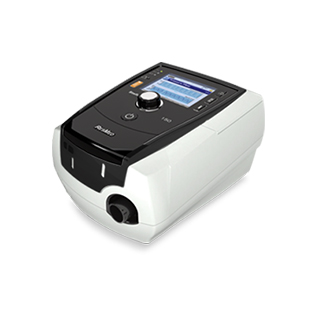The goal of mechanical ventilation is to support patients suffering from respiratory failure.1 Ventilation improves the exchange of gases and reduces the patient’s work of breathing.2
Non-invasive ventilation (NIV) supports the patient’s breathing without the need for intubation or a tracheotomy. NIV delivers effective therapy with less risk of infection and improved survival in patients with respiratory failure.3-5
Non-invasive ventilation supports the patient by:

Non-invasive ventilation is gaining acceptance around the world as the preferred choice of treatment5 over invasive ventilation. Suitable for patients in the hospital or the home, non-invasive ventilation:
Makes day-to-day activities easier. Effective NIV therapy can help patients use more of their lung capacity. This in turn decreases the work of breathing,4 making routine activities easier.
Helps alleviate a range of symptoms. Morning headaches, daytime fatigue and shortness of breath are just some of the daytime symptoms that may occur due to low levels of oxygen or accumulated carbon dioxide. By helping to normalize CO2 and O2 levels in the body, non-invasive ventilation therapy helps relieve symptoms over time to improve the patient’s quality of life.3
May reduce time in hospital and prevent disease from worsening. Patients treated with non-invasive ventilation therapy tend to spend less time in the hospital.3 By ensuring adequate ventilation, NIV patients may be able to avoid respiratory failure. Often prescribed for in-home treatment, NIV therapy is both convenient and effective.
Your patient may need the help of a ventilator to breathe as a result of a medical condition such as:
Invasive mechanical ventilation can become a lifesaving intervention for your patients with respiratory and breathing difficulties. The term ‘invasive’ is used if it involves any instrument penetrating via the mouth (such as an endotracheal tube), nose, or the skin (such as a tracheostomy tube through a stoma, a surgically-created hole in the windpipe) to serve as an artificial airway.6
The objectives of mechanical ventilation are primarily to provide oxygen, remove carbon dioxide, decrease the work of breathing and reverse life-threatening conditions such as hypoxemia, or insufficient oxygenation of arterial blood, and acute progressive respiratory acidosis, or build-up of carbon dioxide in the blood.6

There are two tubes used for invasive mechanical ventilation:
Invasive ventilation may be used during acute respiratory failure, weaning and for chronic respiratory failure when non-invasive ventilation is impossible to manage correctly. It can also be used as a means to maintain a patient’s airway during a surgical procedure, such as intubation done in the ICU.
Whether it is used in a hospital setting or at home (home mechanical ventilation), invasive mechanical ventilation is paired with ventilation technology that continuously facilitates oxygen exchange/carbon dioxide exchange.8 At ResMed, we provide devices with several modes that use the latest technology for the most comfortable and effective therapy.

Personalised non-invasive ventilation for non-dependent patients with COPD and other respiratory insufficiencies.
Read more
Portable non-invasive ventilation with invasive capabilities, for non-dependent patients with progressive conditions or changing needs.
Read more
Versatile invasive and non-invasive ventilation for less dependent to fully dependent patients in need for acute and/or long-term care.
Read moreTobin M (ed.), Principles and practice of mechanical ventilation, 3rd ed,1994.
Tobin M (ed.), Principles and practice of mechanical ventilation, 3rd ed,1994.
International Consensus Conferences in Intensive Care Medicine: noninvasive positive pressure ventilation in acute Respiratory failure. Am J Respir Crit Care Med, 2001.
Robert D, Argaud L. Clinical review: long-term noninvasive ventilation. Crit Care, 2007.
International Consensus Conferences in Intensive Care Medicine: noninvasive positive pressure ventilation in acute Respiratory failure. Am J Respir Crit Care Med. 2001 Organized jointly by the American Thoracic Society, the European Respiratory Society, the European Society of Intensive Care Medicine, and the Société de Réanimation de Langue Française, and approved by ATS Board of Directors, December 2000.
Duke, G.J. Bersten, AD. Non-Invasive Ventilation for Adult Acute Respiratory Failure. Part II Critical Care and Resuscitation, 1999.
Tobin M. Advances in mechanical ventilation. N Engl J Medi 2001; 344:1986-1996.
Khine HH. et al. Comparison of cuffed and uncuffed endotracheal tubes in young children during general anesthesia. Anesthesiology. 1997 Mar; 86(3):627-31.
Windisch, W. et al. Guidelines for Non-Invasive and Invasive Mechanical Ventilation for Treatment of Chronic Respiratory Failure. German Society for Pneumology (DGP): 640-652.